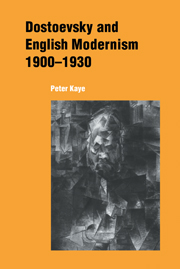Book contents
- Frontmatter
- Contents
- Acknowledgments
- 1 Introduction
- 2 Prophetic rage and rivalry: D. H. Lawrence
- 3 A modernist ambivalence: Virginia Woolf
- 4 Sympathy, truth, and artlessness: Arnold Bennett
- 5 Keeping the monster at bay: Joseph Conrad
- 6 Dostoevsky and the gentleman–writers: E. M. Forster, John Galsworthy, and Henry James
- Conclusion
- Notes
- Selected bibliography
- Index
5 - Keeping the monster at bay: Joseph Conrad
Published online by Cambridge University Press: 22 September 2009
- Frontmatter
- Contents
- Acknowledgments
- 1 Introduction
- 2 Prophetic rage and rivalry: D. H. Lawrence
- 3 A modernist ambivalence: Virginia Woolf
- 4 Sympathy, truth, and artlessness: Arnold Bennett
- 5 Keeping the monster at bay: Joseph Conrad
- 6 Dostoevsky and the gentleman–writers: E. M. Forster, John Galsworthy, and Henry James
- Conclusion
- Notes
- Selected bibliography
- Index
Summary
Malcolm Arbuthnot's photograph of Conrad, taken in 1924, shows the novelist as he would like to be remembered. Dressed in a well-tailored jacket and cravat with a gold fob looping from his pocket, he appears guarded and composed, bearing the refined manner of a landed aristocrat. The photograph conveys the image of Conrad that he himself cultivated throughout his essays, prefaces, and letters. The artist, with unswerving dedication, asserts control over everything he touches, creating order from disorder and achieving, with “precise intention,” a “perfect blending of form and substance.” This image of artist as fastidious god seems far removed from the violent tumult of Dostoevsky's artistic world, distant from the “soothing” voice of authorial style so admired by Conrad. Yet the eyes in the photograph belie the image of Artist in Control. The photograph confirms Lady Ottoline Morrell's first impression of Conrad: “His eyes under their pent-house lids revealed the suffering and the intensity of his experience… yes, it was a tangled, tortured, and very complex soul that looked out through those mysterious eyes.” In these mysterious and suffering eyes, one finds subtle evidence of a hidden kinship between the two writers.
Conrad, however, vehemently denied any affinity with Dostoevsky. He consistently sought to distance himself from the writer who epitomized all that he hated about the country that oppressed his homeland and brought his parents to a premature death.
- Type
- Chapter
- Information
- Dostoevsky and English Modernism 1900–1930 , pp. 118 - 155Publisher: Cambridge University PressPrint publication year: 1999



